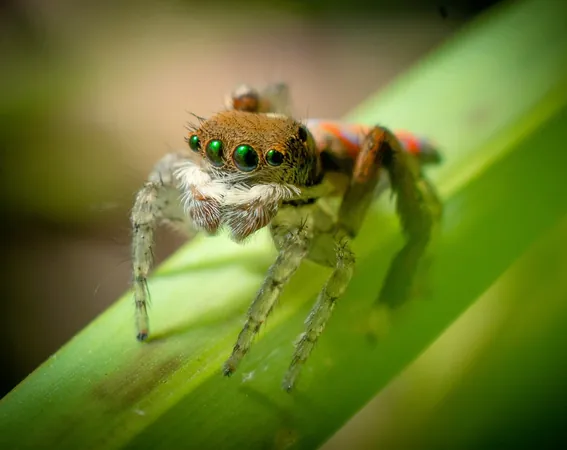
The Spider That Dances Like a Wasp: Unraveling Nature's Masterful Deception
2025-07-18
Author: Wei
In the wild world of survival, appearances can be misleading. A gentle flutter could signal danger, while vibrant colors might scream toxicity or allure. Yet, few creatures engage in the art of deception quite like the Maratus vespa—a remarkable jumping spider that mimics one of its natural predators: the wasp.
This peculiar behavior led scientists from the University of Cincinnati to delve into a unique question: why on Earth would a spider mimic a creature that poses a significant threat, especially during the vital process of courtship?
Unmasking the Mystery with Technology
When field research came to a standstill due to the COVID-19 pandemic, curiosity didn't wane. Scientists embarked on a virtual journey, employing computer vision and machine learning to decode the secrets behind this eye-catching disguise.
To achieve this, they turned to advanced technology. Neural networks were trained to identify various insect and arachnid species based purely on visual patterns and shapes. The groundbreaking research included analyzing 62 species, spanning from jumping spiders to wasps.
Shocking Results: AI Confuses Spiders for Wasps
The outcomes were astonishing. The AI misidentified creatures more than 12% of the time, particularly struggling with the Maratus vespa. In fact, it mistook this spider for a wasp over 20% of the time, highlighting the effectiveness of its mimicry beyond mere human perception.
"This type of mimicry isn't just about human misperception; it can trick even machines," observed Olivia Harris, a researcher involved in the study.
The Dance of Deception
The Maratus vespa doesn’t just look like a wasp; it also performs a mesmerizing dance during mating rituals. This spider showcases bold colors resembling those of wasps while simultaneously raising unique flaps on its body, creating the illusion of a wasp’s triangular head.
Why would it take such a gamble in a moment as precarious as courtship? The answer lies in evolutionary strategy: By mimicking a predator, the male spider captures the female's attention at a critical moment.
Catching Attention: A Dangerous Strategy
Jumping spiders rely heavily on their keen vision, complete with multiple sets of eyes. Females, in particular, are astute observers. When sensing potential danger nearby—like a wasp—females tend to freeze, assessing the situation.
This moment of alertness is precisely when the male seizes the opportunity to initiate his courtship display, using visual mimicry to ensure he’s not overlooked.
Nature's Deceit: A Rare Strategy
Mimicry isn’t unique to spiders, as many animals adopt deceptive tactics during mating. For example, male moths imitate bat calls to keep females from fleeing. In the animal kingdom, it’s a fascinating landscape filled with strategy and deception.
However, the Maratus vespa's visual mimicry stands out as exceptionally rare, particularly since it's employed in a courtship context. This behavior signifies a complex form of sensory exploitation, allowing the male spider to take advantage of how females process visual threats.
The Illusion's Limits
Professor Nathan Morehouse, a co-author of the study, clarified that while the mimicry is effective from afar, it is dependent on specific viewing angles which enhance the illusion. However, as the male approaches, the facade begins to crumble. Females become aware of their mate’s true nature, ensuring they can still make informed choices.
"The mimicry serves as a tool for initial attraction, not as a permanent deception,” Morehouse stated.
The Journey Continues
The researchers are eager to conduct further studies on how live female spiders respond to male mimicry. Are some jumping spiders more adept at this imitation than others? Could variations in appearance influence mating success? Such inquiries promise to deepen our understanding of deception’s role in both survival and romance.
For now, the Maratus vespa continues its captivating performance in the wilds of Australia, dancing its bright, risk-laden dance in the pursuit of love.


 Brasil (PT)
Brasil (PT)
 Canada (EN)
Canada (EN)
 Chile (ES)
Chile (ES)
 Česko (CS)
Česko (CS)
 대한민국 (KO)
대한민국 (KO)
 España (ES)
España (ES)
 France (FR)
France (FR)
 Hong Kong (EN)
Hong Kong (EN)
 Italia (IT)
Italia (IT)
 日本 (JA)
日本 (JA)
 Magyarország (HU)
Magyarország (HU)
 Norge (NO)
Norge (NO)
 Polska (PL)
Polska (PL)
 Schweiz (DE)
Schweiz (DE)
 Singapore (EN)
Singapore (EN)
 Sverige (SV)
Sverige (SV)
 Suomi (FI)
Suomi (FI)
 Türkiye (TR)
Türkiye (TR)
 الإمارات العربية المتحدة (AR)
الإمارات العربية المتحدة (AR)